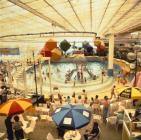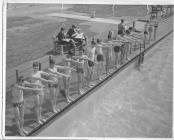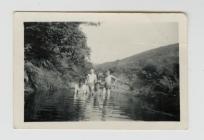The Lost Lidos of Wales
Items in this story:
Introduction
For those of a certain age, memories abound of jumping into freezing water of an open-air swimming pool during the pre-season schools sessions provided by the local council in an effort to teach children to swim. That same group of people will also have memories of those pools being closed down, demolished and filled in – a tragic story that is sadly widespread across Wales and Britain as a whole. Unlike long-lived public parks and welfare grounds or the managed natural landscape, many public swimming pools, built with such enthusiasm in the 1920s and 1930s, did not survive the twentieth century.
By 2012, none of them remain in use as they were originally built and only a handful, such as the baths in Maesteg, Porth and Splott, have survived because they were converted into indoor facilities. Despite these tales of loss, the history of Wales’s lost lidos is actually one of great enthusiasm and hope; of aspiration and triumph over adversity. As Aneurin Bevan recalled in 1937: ‘When I was a boy those who wanted to learn to swim went to the mountain pools and tarns, which were also a great repository of dead dogs […] therefore our local authority attached very great importance to the construction of an open-air swimming bath and it is now a source of great pleasure to all of us on a summer’s day’.
Swimming in the river
Swimming is one of the oldest known sporting activities; yet, aside from Roman baths such as the Natatio in Caerleon, it is only since the nineteenth century that the landscape of urban Britain has been altered to provide dedicated facilities for the general public. For the most part, of course, people went swimming in canals, rivers, streams, ponds, lakes, and in the sea. Swimming in public was not welcomed by everyone, though, particularly since most people did so naked. ‘It is clearly his duty not to go into the water at all’, exclaimed one Welsh newspaper when chapel leaders complained about public nudity near popular swimming spots.
The challenge for proprietors of swimming baths (especially local councils) was encouraging public bathers into their new facilities and to make them going concerns. This was not as straight forward as it might seem: divisions between a first-class bath and a second-class bath were not simply down to the price. Those who went swimming in the second-class bath plunged into water that had already been used in the first-class bath. Whether at the Corporation Baths on Guildford Crescent in Cardiff (at least until they were rebuilt in the 1890s) or at the open-air swimming baths in Pontycymer and Cowbridge, patrons were, quite literally, paying to swim in someone else’s dirt. Little wonder that, faced with the choice of swimming for free in dirty river water or paying for the same privilege in the public baths, most kept their pennies for other things.
Corporation Baths and Workmen’s Halls
By the early twentieth century, indoor swimming baths had been built in major towns including Cardiff, Newport, Aberystwyth, Penarth and Wrexham. The Tuttle Street Baths in Wrexham were notable for being heated by the town’s incinerator in what was recognised as a pioneering and environmentally friendly initiative. The Stow Hill baths in Newport championed dual use with the pool being drained in the winter months and converted into a dance hall and gymnasium. And, though they were filled with salty sea water, the Penarth swimming baths were regularly used for local and national competitions given their size and the lack of a full-sized swimming pool in Cardiff.
Across the South Wales Coalfield, too, a new, golden era of public leisure amenities was being ushered in with open-air swimming baths provided in Abertillery, Aberdare, Aberavon, Abersychan, Pontnewynydd, and Swansea in the years leading up to the Great War. The same was true of workmen’s halls, which were beginning to outgrow their original purpose as institutions of learning and developing into all-round community venues with facilities for recreation as well as education. When Nixon’s Workmen’s Hall opened in Mountain Ash in 1899 there was a large swimming baths in the basement and numerous institutes followed suit. The first swimming baths in the Rhondda, for example, were located in the Workmen’s Hall in Llwynypia and later there were also swimming baths at the Ferndale and Blaenllechau Workmen’s Hall. Elsewhere, there were swimming baths at Aberaman Workmen’s Hall, Powell Tillery Workmen’s Hall in Abertillery and at Nine Mile Point Workmen’s Hall in Cwmfelinfach.
In later years, the miner’s committees (and their equivalent in non-mining areas) turned their attention to building open-air swimming pools as part of welfare ground brimming with new playing fields and play equipment. Later still they built paddling pools using funds raised at the work canteen. Such facilities were typical of communities that embraced voluntary action. Aided, in the 1920s and 1930s, by statutory bodies such as the Miners’ Welfare Fund and the Special Areas Commission, volunteers constructed a network of swimming pools stretching from Buckley Baths in the north-east to Hendy Baths in Carmarthenshire, Cold Knap in Barry and those in Eugene Cross Park, Ebbw Vale, which were opened by Aneurin Bevan in May 1931. Alongside a wave of new council swimming pools such as those at Gelligaled Park in the Rhondda, on East Parade in Rhyl, and in Llandaff Fields in central Cardiff, these welfare baths contributed significantly to the increased importance of swimming and other aquatic sports including water polo and diving. New clubs were formed shortly after the pool opened – Pontypridd Swimming Club, for example, were set up in 1928 just a few months after the town’s lido was unveiled in the summer of 1927.
By the outbreak of the Second World War, there were more swimming pools in Wales than ever before. Most, of course, were open-air and therefore available for use only during the summer months. The greatest concentration was in Glamorgan and Monmouthshire where the combination of council effort, voluntary action, and historical development contributed to a network of facilities that extended the length and breadth of the two counties. In the west, Carmarthenshire dominated with towns such as Aberystwyth providing minor facilities for the tourist trade. The town had lost its Victorian baths to a cinema in the early 1920s and these would not be replaced until the opening of Plascrug Swimming Pool in the 1973. The tourist trade along the North Wales Coast accounted for the majority of its classic open-air swimming pools. The lidos at Llandudno, Prestatyn, Rhos-on-Sea and Rhyl helped these towns, fearful as they were of losing tourists to Blackpool and other nearby resorts such as Morecambe and Southport, to compete for visitors. In South Wales, the refurbishment and enlargement of the baths on Knightstone Island in Weston-Super-Mare in the early 1880s had encouraged Penarth’s council to build its own swimming baths. These opened in 1885.
From Warm Water to Wave machines
The years after the Second World War have seen a turn away from the open-air swimming pools and lidos of the 1920s and 1930s. In their place are modern, indoor pools complete with heated water, slides and wave machines. These indoor facilities often form part of a bigger leisure centre equipped with gyms, squash courts and sports halls. The first modern swimming pool to be built in Wales was the Empire Pool, which opened in April 1958 to much critical acclaim. The origins of the Empire Pool lie in Cardiff Corporation’s plans to redevelop Wood Street and the area in front of Cardiff Central Station (then the Great Western Station) which had been the site of Temperance Town until the 1930s. The construction of Cardiff’s bus station, which was carried out, was to have been partnered with a sports village that included a modern, competition-length swimming pool and ice rink, which was not. When Sir Robert Webber, the editor of the Western Mail, made his call on BBC radio in 1938 for the Empire Games to be brought to Wales envisaged the swimming competition being held at the open-air Llandaff Fields baths. Such was the confidence in the council achieving its grand vision.
The Empire Pool was a phenomenon unique to Britain at that time. Prior to its construction, there was just one Olympic-sized pool in the entire country: that at Blackpool, which opened in 1939. The Empire Pool in Wembley had closed at the conclusion of the swimming competitions of the 1948 Olympics. Cardiff’s new pool corrected a long-standing problem for the city. When the council had refurbished the Corporation Baths on Guildford Crescent in the 1890s, it had failed to extend the main pool to the necessary length for international competition and as a result Cardiff could not host major swimming meets. Instead these were held at the indoor pool in Penarth or at the Cold Knap baths in Barry. Had Cardiff failed to construct the Empire Pool in time for the Empire Games in 1958, then the swimming competitions would have been held at Barry.
As a result of its success and continuing popularity, the Empire Pool proved the catalyst for a wave of new development stretching over twenty years. Whether it was in the form of new facilities such as the swimming baths at Aberavon (the Afan Lido, which opened in 1965) or at Harlech, Aberystwyth, Cardigan and Llantrisant; or it was in the form of conversions such as took place at Maesteg, Wales’ network of swimming pools was being both upgraded and radically altered. A new phase came during the Jubilee Year of 1977 when the Queen arrived in Swansea to open the city’s brand new leisure centre. The new pool did away with the traditional and instead provided visitors with wave machines, slides and other features more typical of a continental waterpark. Three years later, Rhyl’s Sun Centre opened and this time featured a surfing pool and a monorail in addition to the wave machine and slides. By the beginning of the 1990s, even the Afan Lido had been transformed into the Aquadome that attracted thousands of visitors every year and few swimming pools survived without some form of waterpark feature.
Decline and Fall?
If the Rhyl Sun Centre and Port Talbot’s revamped Aquadome marked the high points of the 1980s and early 1990s as far as swimming pools are concerned, the reality for many others – especially the open-air swimming baths of the interwar years – is much less rosy. Much of Wales’ interwar legacy disappeared during the long years of Conservative government in the 1980s and 1990s. Lack of investment and changing habits saw swimming pools closed down or neglected. Some survived through conversion to indoor use but most were got rid of in favour of centralised leisure centres. This process has continued right up until recently with the last of the open-air lidos closing only in 2010.
What has happened over the last century, of course, is not unique to Wales. Right across Britain and Ireland (and much of Europe) investment in facilities for swimming has fluctuated with peaks and troughs depending on current political will and financial opportunity. Yet, it is apparent that in Wales there has been a Golden and Silver age of investment and construction. The Golden Age of the 1920s and 1930s when voluntary action and hard work overcome the worst of financial times and the Silver Age of the 1960s and 1970s when indoor facilities emerged to compliment (or replace in the case of the oldest pools) those of the interwar years.
Story by Daryl Leeworthy, RCAHMW (author of 'Fields of Play', 2012).




